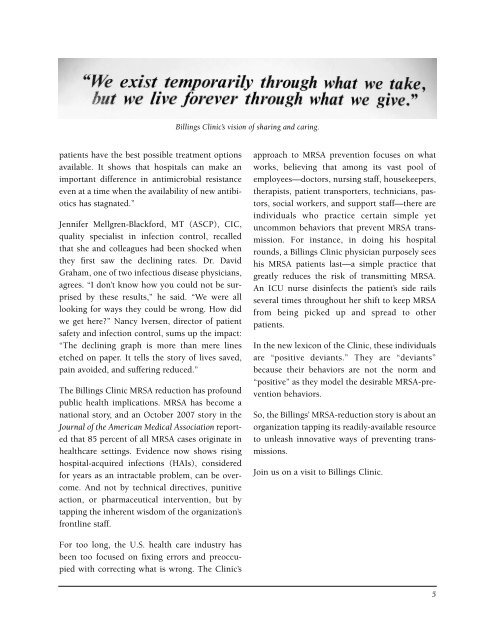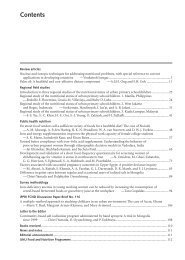From Invisible to Visible - Positive Deviance Initiative
From Invisible to Visible - Positive Deviance Initiative
From Invisible to Visible - Positive Deviance Initiative
Create successful ePaper yourself
Turn your PDF publications into a flip-book with our unique Google optimized e-Paper software.
Billings Clinic’s vision of sharing and caring.<br />
patients have the best possible treatment options<br />
available. It shows that hospitals can make an<br />
important difference in antimicrobial resistance<br />
even at a time when the availability of new antibiotics<br />
has stagnated.”<br />
Jennifer Mellgren-Blackford, MT (ASCP), CIC,<br />
quality specialist in infection control, recalled<br />
that she and colleagues had been shocked when<br />
they first saw the declining rates. Dr. David<br />
Graham, one of two infectious disease physicians,<br />
agrees. “I don’t know how you could not be surprised<br />
by these results,” he said. “We were all<br />
looking for ways they could be wrong. How did<br />
we get here?” Nancy Iversen, direc<strong>to</strong>r of patient<br />
safety and infection control, sums up the impact:<br />
“The declining graph is more than mere lines<br />
etched on paper. It tells the s<strong>to</strong>ry of lives saved,<br />
pain avoided, and suffering reduced.”<br />
The Billings Clinic MRSA reduction has profound<br />
public health implications. MRSA has become a<br />
national s<strong>to</strong>ry, and an Oc<strong>to</strong>ber 2007 s<strong>to</strong>ry in the<br />
Journal of the American Medical Association reported<br />
that 85 percent of all MRSA cases originate in<br />
healthcare settings. Evidence now shows rising<br />
hospital-acquired infections (HAIs), considered<br />
for years as an intractable problem, can be overcome.<br />
And not by technical directives, punitive<br />
action, or pharmaceutical intervention, but by<br />
tapping the inherent wisdom of the organization’s<br />
frontline staff.<br />
approach <strong>to</strong> MRSA prevention focuses on what<br />
works, believing that among its vast pool of<br />
employees—doc<strong>to</strong>rs, nursing staff, housekeepers,<br />
therapists, patient transporters, technicians, pas<strong>to</strong>rs,<br />
social workers, and support staff—there are<br />
individuals who practice certain simple yet<br />
uncommon behaviors that prevent MRSA transmission.<br />
For instance, in doing his hospital<br />
rounds, a Billings Clinic physician purposely sees<br />
his MRSA patients last—a simple practice that<br />
greatly reduces the risk of transmitting MRSA.<br />
An ICU nurse disinfects the patient’s side rails<br />
several times throughout her shift <strong>to</strong> keep MRSA<br />
from being picked up and spread <strong>to</strong> other<br />
patients.<br />
In the new lexicon of the Clinic, these individuals<br />
are “positive deviants.” They are “deviants”<br />
because their behaviors are not the norm and<br />
“positive” as they model the desirable MRSA-prevention<br />
behaviors.<br />
So, the Billings’ MRSA-reduction s<strong>to</strong>ry is about an<br />
organization tapping its readily-available resource<br />
<strong>to</strong> unleash innovative ways of preventing transmissions.<br />
Join us on a visit <strong>to</strong> Billings Clinic.<br />
For <strong>to</strong>o long, the U.S. health care industry has<br />
been <strong>to</strong>o focused on fixing errors and preoccupied<br />
with correcting what is wrong. The Clinic’s<br />
5

















